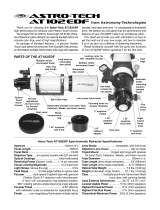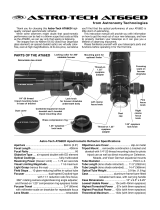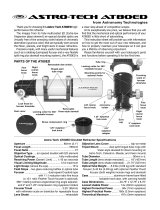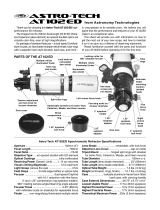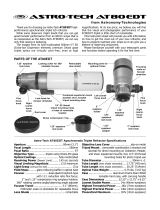Page is loading ...

Specifications
Optical Design Rowe-Ackermann Schmidt
Aperture 279 mm
Focal Length 620 mm
Focal Ratio 2.22
Central obstruction diameter 114 mm
Optical Coatings StarBright XLT
Total Telescope Kit Weight 35 lbs
Optical Window Broadband AR fully-multicoated removable optical window
Focuser FeatherTouch MicroFocuser, 10:1 fine focus ratio
Cooling Fan 12V DC, tip positive polarity
Optical Tube Length 33 in
Backfocus from included camera adapters 55 mm
Total back focus from flat surface above optical window 72.8 mm
On-axis RMS spot size <2.00 µm
RMS spot size 21 mm off-axis <2.25 µm
Relative illumination 21 mm off-axis 83%
Optimized Image Circle Diameter 43.3 mm
Total Usable Field 52 mm
Rowe-Ackermann Schmidt Astrograph
Telescope
INSTRUCTION MANUAL
Model: 91075
CELESTRON TWO YEAR LIMITED WARRANTY
A. Celestron warrants your telescope mount to be free from defects in materials and workmanship for two years.
Celestron will repair or replace such product or part thereof which, upon inspection by Celestron, is found to be
defective in materials or workmanship. As a condition to the obligation of Celestron to repair or replace such product,
the product must be returned to Celestron together with proof-of-purchase satisfactory to Celestron.
B. The Proper Return Authorization Number must be obtained from Celestron in advance of return. Call Celestron at
(310) 328-9560 to receive the number to be displayed on the outside of your shipping container.
All returns must be accompanied by a written statement setting forth the name, address, and daytime telephone
number of the owner, together with a brief description of any claimed defects. Parts or product for which replacement
is made shall become the property of Celestron.
The customer shall be responsible for all costs of transportation and insurance, both to and from the factory of
Celestron, and shall be required to prepay such costs.
Celestron shall use reasonable efforts to repair or replace any telescope mount covered by this warranty within thirty
days of receipt. In the event repair or replacement shall require more than thirty days, Celestron shall notify the
customer accordingly. Celestron reserves the right to replace any product which has been discontinued from its
product line with a new product of comparable value and function.
This warranty shall be void and of no force of effect in the event a covered product has been modified in de-
sign or function, or subjected to abuse, misuse, mishandling or unauthorized repair. Further, product malfunction or
deterioration due to normal wear is not covered by this warranty.
CELESTRON DISCLAIMS ANY WARRANTIES, EXPRESS OR IMPLIED, WHETHER OF MERCHANTABILITY OF
FITNESS FOR A PARTICULAR USE, EXCEPT AS EXPRESSLY SET FORTH HEREIN. THE SOLE OBLIGATION OF
CELESTRON UNDER THIS LIMITED WARRANTY SHALL BE TO REPAIR OR REPLACE THE COVERED PRODUCT, IN
ACCORDANCE WITH THE TERMS SET FORTH HEREIN. CELESTRON EXPRESSLY DISCLAIMS ANY LOST PROFITS,
GENERAL, SPECIAL, INDIRECT OR CONSEQUENTIAL DAMAGES WHICH MAY RESULT FROM BREACH OF ANY
WARRANTY, OR ARISING OUT OF THE USE OR INABILITY TO USE ANY CELESTRON PRODUCT. ANY WARRANTIES
WHICH ARE IMPLIED AND WHICH CANNOT BE DISCLAIMED SHALL BE LIMITED IN DURATION TO A TERM OF TWO
YEARS FROM THE DATE OF ORIGINAL RETAIL PURCHASE.
Some states do not allow the exclusion or limitation of incidental or consequential damages or limitation on how long
an implied warranty lasts, so the above limitations and exclusions may not apply to you.
This warranty gives you specific legal rights, and you may also have other rights which vary from state to state.
Celestron reserves the right to modify or discontinue, without prior notice to you, any model or style telescope.
If warranty problems arise, or if you need assistance in using your telescope mount contact:
CELESTRON, LLC. Customer Service Department
2835 Columbia Street • Torrance, CA 90503 • Tel. 800.421.9649
Monday-Friday 8AM-4PM PST • ©2017 Celestron • All rights reserved • 04-17
NOTE: This warranty is valid to U.S.A. and Canadian customers who have purchased this product from an authorized
Celestron dealer in the U.S.A. or Canada. Warranty outside the U.S.A. and Canada is valid only to customers who
purchased from a Celestron’s International Distributor or Authorized Celestron Dealer in the specific country. Please
contact them for any warranty service.
Dew Prevention
The Schmidt corrector is especially susceptible to condensation forming because the glass is
immediately exposed to the outside air, just like the windshield on your car. If the temperature
outside drops below the dew point, dew may form on the corrector within minutes.
The easiest way to prevent dew is to add an optional dew shield, available from Celestron,
which shrouds the corrector and keeps the air immediately surrounding the corrector slightly
warmer than the ambient temperature. If conditions are more severe, a dew heater, commonly
available from other manufacturers, can be added to apply slight heat to the corrector lens to
keep it dry all night.
If dew has already formed on the corrector, point the telescope downward and allow the
telescope to dry. You can also use a hairdryer to heat the corrector and evaporate the moisture
to dry the telescope.
Dew does not harm the telescope, but can lead to faster dust build up. Do not store the
telescope if covered in dew. Allow the telescope to dry first.
Care and Cleaning of the Optics
Dust should normally be removed with a pressured air can, or a camel hair brush. Spray at an
angle to the lens for approximately two to four seconds. Then, use an optical cleaning solution
and white tissue paper to remove any remaining debris. Apply the solution to the tissue and
then apply the tissue paper to the lens. Low pressure strokes should go from the center of the
corrector to the outer portion. Do NOT rub in circles!
You can use a commercially made lens cleaner or mix your own. A good cleaning solution is
isopropyl alcohol mixed with distilled water. The solution should be 60% isopropyl alcohol and
40% distilled water. Or, liquid dish soap diluted with water (a couple of drops per one quart of
water) can be used.
To minimize the need to clean your telescope, replace the dust cap once you have finished
using it.
Internal adjustments and cleaning should be done only by the Celestron repair department. If
your telescope is in need of internal cleaning, please call the factory for a return authorization
number and price quote.

Installing a Camera
Use one of the two supplied camera adapters to attach to your DSLR or CCD camera. The
M42 adapter fits most cameras with standard T-threads. The wider M48 adapter can be
used with full frame cameras with minimal vignetting. DSLR cameras require a T-ring, sold
separately, for the make and model of your camera.
CCD cameras have a wide range of backfocus, depending on the model and accessories
used. The included camera adapters allow 55 mm of distance from the adapter to the
imaging sensor. If your CCD camera consumes less than 55 mm, you will need to add a
spacer to reach the correct distance.
Cameras with sensors larger than 43 mm diagonal (full frame) will require a custom adapter
to better illuminate the sensor. Refer to Celestron’s website for a drawing of our camera adapter
dimensions to help determine how a custom adapter should be made.
Note: Due to the steep light cone at f/2.2, camera housings can be a source of vignett-
ing. Despite having a large illuminated field (78% 21 mm off-axis), vignetting can occur
when using custom adapters and when a steep housing surrounds the sensor. This is
common with DSLR sensors, sometimes resulting in rectangular vignetting.
To attach your camera:
1. Place the knurled retaining ring over the camera adapter and loosely thread it onto
the telescope.
2. Holding your camera, thread the camera body (or T-ring, if a DSLR is used) to the
camera adapter.
3. Carefully hold the camera so the camera adapter seats flatly.
4. Finish threading the retaining ring onto the telescope. Turn until the camera adapter is
snug against the telescope. Do not over tighten! Camera orientation can be adjusted later.
Caution: Over tightening the camera adapter can increase the chance of loosening
the lens assembly on the corrector, or cause the lens assembly to rotate against the
corrector. Keep the camera adapter snug against the telescope, but do not over tighten.
Adjusting Camera Orientation
Once the camera is installed, you can rotate it by slightly loosening the retaining ring. Loosen
the ring no more than 1/8
th
turn, rotate the camera as desired, and retighten the ring,
remembering not to over tighten.
Fan Operation and Optics Cool Down
It takes time for the optics of the Astrograph to reach thermal equilibrium with the
outside air. The greater the temperature difference between where the Astrograph is
stored and the outdoors, the longer it takes to cool down.
The Astrograph is equipped with a cooling system containing a 12-volt fan. The battery
pack requires 8 AA battaries (not included). Install the battaries as indicated in the
plastic mold of the battery holder. Plug in the supplied battery pack to power the fan
before using the Astrograph. You can do this while preparing your camera equipment.
Focusing
The Feather Touch Micro Focuser knob moves the primary mirror on the rear cell of the
telescope. The larger black knob is the coarse focus; the smaller orange knob is the 10:1
fine focus. Turn the focusing knob until the image is sharp on your camera. If the knob
will not turn, it has reached the end of its travel on the focusing mechanism. A single turn
of the focusing knob moves the primary mirror only slightly. Therefore, it will take many
turns (about 30) to go from close focus to infinity.
If you turn the focus knob too quickly, you can go right through focus without seeing
the image. To avoid this problem, your first astronomical target should be a bright object
(like the Moon or a planet) so that the image is visible even when out of focus. Critical
focusing is best accomplished when the focusing knob is turned counterclockwise so that
the mirror moves against the pull of gravity. This minimizes mirror shift.
Mirror Support Clutches
The Astrograph is equipped with mirror tension clutches to help support and minimize
movement of the primary mirror during long exposures.
To use the mirror clutches:
1. Use the focus knob to adjust the primary mirror to the desired focus.
2. Once in focus, turn the two mirror lock knobs clockwise until both are very tight and
can be turned no further.
Warning! Once the mirror is locked down, do not turn the focuser knob without loos-
ening the mirror locks first. Although turning the focus knob should not damage the
telescope, undue stress can be placed on the focus mechanisms causing excessive image
shift while focusing.
Collimation
The telescope is factory aligned, but may need a slight adjustment after it is transported.
The primary mirror and corrector are permanently aligned at the factory. You can make
adjustments to the tilt of the lens assembly if needed.
The Astrograph must be collimated with the camera installed. We recommend using a
camera that does not obstruct the light path of the telescope, making it easier to see
concentric star patterns.
Equipment needed:
2 mm Hex key
3 mm Hex key
Artificial star or a star outside at night, such as Polaris
Camera setup, ready to image
1. Install the camera on the telescope as described in the “Installing a Camera” section
of this manual.
2. Rotate the camera adapter so that the 3 slotted openings allow access to the
collimation screws
3. Point the Astrograph at your star and focus the camera.
4. Defocus the star about 1 turn, using the coarse focus knob on the Feather
Touch Microfocuser.
5. Inspect the star pattern. When collimated, the pattern should look like a concentric
doughnut. If the pattern is concentric, no adjustment is necessary.
6. Adjust the telescope collimation if needed by slightly loosening a 3mm socket head
screw, and tightening the paired 2mm socket head screw. The screws work as push/pull,
tightening one requires loosening the other. Always adjust one pair of screws at a time.
7. If the star pattern is thin on one side, adjust the collimation so that the star moves
towards the thin side, then adjust the position of the Astrograph to re-center the star.
Repeat this until you achieve correct collimation.
Removing the Optical Window
The optical window can be removed and replaced with a filter, such as a light pollution
filter to improve contrast.
1. With the camera adapter removed, carefully grab hold of the knurled cell of the
optical window.
2. Carefully unthread the optical window from the Astrograph.
Attaching Accessories
The Astrograph includes a CGE-style dovetail which is also cross compatible with
most accessories that work on the Losmandy D plate. The accessory dovetail can be
used to mount an optional guidescope. The Celestron 80 mm Guide Scope package is
compatible with the accessory dovetail.
A Celestron 50 mm finder scope can also be attached using the threaded holes on the
rear cell of the telescope.
1 Front Lens Group 6 Mirror Lock Knobs
2 Corrector 7 10:1 Feather Touch Micro Focuser
3 Optical Window Cell 8 12V DC Input for Cooling Fan
4 Collimation Screws 9 Cooling Fan
5 Accessory Dovetail Plate
Overview
3
7
4
1
2
5
6
8
9
Knurled
retaining
ring
Collimation
screws
2 mm
Hex key
3 mm
Hex key
Knurled cell of
optical window
Parts List
Optical Tube Assembly, M42 Camera T-adapter, M48 Wide Camera Adapter, Retaining Ring, 8 x AA Battery Pack (batteries not included), Dust Cap
The Rowe-Ackermann Schmidt Astrograph delivers a flat field, coma-free image across a large image circle for your imaging camera. The Astrograph can only be used with a camera.
/

